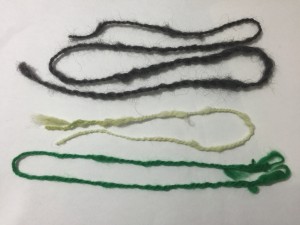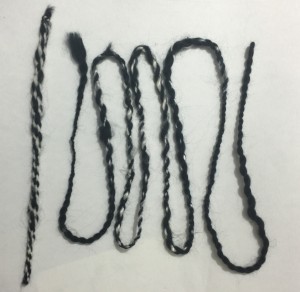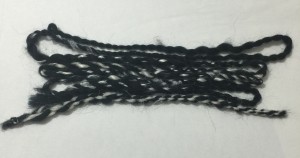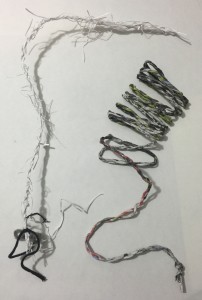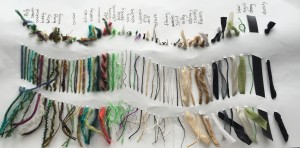I have done my customary analysis of this assignment and excitedly just wanted to make yarn. I looked through all my previous drawings to find suitable lines to refer to and really just drew a blank (no pun intended) It’s not that I don’t like my drawings but my intention when making them was not to interpret the lines as yarn, and my drawing observations, at first perusal seem to have more of a leaning to other types of texture and shade.
I appreciate that this is very much part of the learning process and as my artistic intentions are clearer to me , my observations will be more appropriate. Or my textile interpretations of my drawings will be more appropriate to the marks I make. Currently they don’t seem to match so I need to take a step back and try a different approach.
I decided to just make some yarns.
It seemed important to learn to spin so with the aid of youtube and a drop spindle I gave it a go. How exciting! I can see spinning becoming very moreish, I got a great sense of achievement from making little scraps of yarn, they are varying in thickness and this because I have no practice in pulling the fibres out evenly – but they are unarguably yarn and the process is going to be so useful
The grey yarn is two ply, creamy green is 3ply, green 2ply re-plyed??? perhaps this is 4 ply. Clearly I can be more professional about spinning and learn the spinning vocab -I am a massive fan of technical terms. For now though spinning is too exciting! I can clearly see the linear qualities, I like the fuzzy edges of the grey yarn and recalled some of the charcoal marks I made so changed to using black merino wool and silky stuff that I believe is alpaca (I have a small stash of fibres that I gathered over-excitedly at a wool show. They didn’t all get used in my short foray into felting but somehow the labelling has become a bit mixed up)
My inexperience has paid real dividends! the irregularity of the spin is very like the changing textures in my drawing! The thicker piece is a more even spin that I replyed to make really interesting diagonal marks.
Squashing the yarn together accentuates the charcoal texture. Of the band on my hat
So accidently by experimenting with making I have recreated my mark making, hurrah, result!
In this spirit I decided to play some more. I spun some newspaper and some finely shreded paper. They cast great shadows
I explored my stuff stash and made some more random yarns – well not so random, I was considering mark making, refreshed by looking at all my drawings but not fixed on any one drawing for now. This was to enable me to be freer with experimentation.
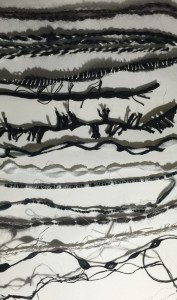 I proved to myself that yarns can express drawn lines.I discovered techniques and materials to play with.
I proved to myself that yarns can express drawn lines.I discovered techniques and materials to play with.
Stretchy jersey is fantastic in the way it rolls in on itself when cut and stretched.
Machine stitching is a super quick way of wrapping – I could experiment with different thickness’s of tread on the bobbin and rhythms of density of stitch.
Stitches show lots of potential, it’s interesting how flat strips of fabric change shape when stitched.
I am particularly excited about the les flexible yarns and the shadows they cast.
There are many marks here but I realised that this approach is a little too random. I could happily invent and play for hours but need to stay aware of the task so a new approach is needed.
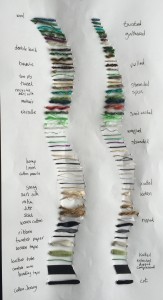 I gathered as many ‘yarns’ as I could find and looked at the structure. Many are spun but they are also wrapped, extruded, knitted, woven, twisted in different ways using different materials. I now have a pile of raw materials and a better awareness of some processes that I could use.
I gathered as many ‘yarns’ as I could find and looked at the structure. Many are spun but they are also wrapped, extruded, knitted, woven, twisted in different ways using different materials. I now have a pile of raw materials and a better awareness of some processes that I could use.
I also took some time to ascribe descriptive words to each yarn, maybe this will help me relate the type of yarn to qualities of particular lines within drawings.
I feel much more prepared and will now return to my drawings with fresh perspective.
